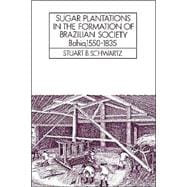
Note: Supplemental materials are not guaranteed with Rental or Used book purchases.
Purchase Benefits
What is included with this book?
| List of figures, maps, and tables | |
| Preface | |
| Abbreviations and special terms | |
| Weights and measures | |
| Part I. Formations, 1500-1600: 1. The sugar plantation: from the Old World to the New | |
| 2. A wasted generation: commercial agriculture and Indian laborers | |
| 3. First slavery: from Indian to African | |
| Part II. The Bahian Engenhos and their World: 4. The Recô | |
| ncavo | |
| 5. Safra: the ways of sugar making | |
| 6. Workers in the cane, workers at the mill | |
| 7. The Bahian sugar trade to 1750 | |
| 8. A noble business: profits and costs | |
| Part III. Sugar Society: 9. A colonial slave society | |
| 10. The planters: masters of men and cane | |
| 11. The cane farmers | |
| 12. Wage workers in a slave economy | |
| 13. The Bahian slave population | |
| 14. The slave family and the limitations of slavery | |
| Part IV. Reorientation and Persistence, 1750-1835: 15. Resurgence | |
| 16. The structure of Bahian slaveholding | |
| 17. Important occasions: the war to end Bahian slavery | |
| Appendixes | |
| Notes | |
| Glossary | |
| Sources and selected bibliography | |
| Sources of figures | |
| Index. |
The New copy of this book will include any supplemental materials advertised. Please check the title of the book to determine if it should include any access cards, study guides, lab manuals, CDs, etc.
The Used, Rental and eBook copies of this book are not guaranteed to include any supplemental materials. Typically, only the book itself is included. This is true even if the title states it includes any access cards, study guides, lab manuals, CDs, etc.